The Che Guevara Blog
Che Guevara full biography
Che Guevara - Full Biography
· Young Ernesto Guevara 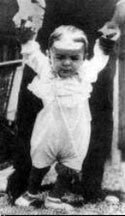 Ernesto Che Guevara de la Serna is born June 14, 1928 in Rosario, one of the most important cities in Argentina, in a well off family. A family with aristocratic roots but socialistic ideas.
Ernesto Che Guevara de la Serna is born June 14, 1928 in Rosario, one of the most important cities in Argentina, in a well off family. A family with aristocratic roots but socialistic ideas.
In 1937, Ernesto is 9 years old and goes to the third grade of primary school; he follows up engagingly the Spanish Civil war. On a map he indicates the military evolution.
In 1947, Ernesto Guevara meets the young Berta Gilda Infante, also known as Tita. She is a member of the Argentine Communist Youth. They build up a profound friendship. Together they read Marxist texts and discuss the actualities.
In 1948, Ernesto, who is 20 years old at that time,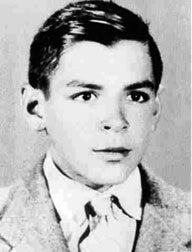 undergoes an examination at the faculty of medicine at the University of Buenos Aires. In March he passes for the examinations of the first year, in June for those of the second year and in December for those from the third year.
undergoes an examination at the faculty of medicine at the University of Buenos Aires. In March he passes for the examinations of the first year, in June for those of the second year and in December for those from the third year.
January 1 1950, Ernesto Guevara attempts his first voyage. He traverses the northern provinces of Argentina on a bicycle on which he adjusted a small motor.
He arrives at San Francisco del Chahar, near Córdoba, where his friend Alberto Granado runs the dispensary of the leper-centre. With the patients he has long conversations about their disease. He continues his university studies and is above all interested in the scientific research for allergies, asthma, leprosy and nutritive theory.
While he is studying, he works as a male nurse on trading and petroleum ships of the Argentine national shipping-company. Like that he travels from the south of Argentina to Brazil, Venezuela and Trinidad.
· A journey through Latin America
In October he decides to make his first trip through Latin-America. Together with Alberto Granado he leaves in January 1952 on an old 'Norton' 500-cc motorbike.
In Valparaiso Chile he writes in his diary: "We are looking for the bottom part of the town. We talk to many beggars. Our noses inhale attentively the misery."
About Chile he writes: "The most important effort that needs to be done is to get rid of the uncomfortable 'Yankee-friend'. It is especially at this moment an immense task, because of the great amount of dollars they have invested here and the convenience of using economical pressure whenever they believe their interests are being threatened."
On March 24 they arrive at the Peruvian Tacna. After a discussion about the poverty in the region, he refers in his notes to the words of José Marti: "I want to link my destiny to that of the poor of this world."

On May 1 they arrive in Lima. Che meets doctor Hugo Pesce, a Peruvian scientist, and director of the national leprosy program and an important Marxist. They discuss several nights until the morning comes. Year's later Che puts that these conversations were very important for the change in his attitude towards life and the society.
On May 17 he leaves for the leper-centre of San Pablo in the Peruvian Amazon forest. He arrives on June 7. During his visit to this place, he complaints about the miserable way that the people of that region and the sick have to live. There were no clothes, almost no food and no medication. After working there for a few weeks, he leaves for Leticia, Colombia via the Amazon River.
July 17 he arrives in Caracas. There he decides to go back to Buenos Aires to finish his studies in medical science. He travels with a cargo-plane via Miami, where the technical problems with the aeroplane give him a delay of one month. To survive, he works as a waiter and he washes dishes in a bar. On regular base he is apprehended and questioned by the police. They ask him if he, his mother or father are communist. He is back in Buenos Aires on August 31. ·
· On his way to the revolution
Che Guevara finished his studies early 1953. He gets summoned for military duty but he was rejected. On July 7 he goes by slow train to La Paz, Bolivia, 6000km further. Che arrives at Panama late October. He is indignant about the submissive attitude of the Panamese leaders towards the U.S. In Costa Rica he learns about the domination of United Fruit and the exploitation and of the misery that is the result of it. In a letter to his aunt Beatriz he writes: "In El Paso I traversed the vast domains of United Fruit. Once more I was able to convince myself how criminal the capitalistic octopuses are. On a picture of our old and bewailed comrade Stalin, I swore not to rest before these capitalistic octopuses are destroyed. In Guatemala I want to get perfect in becoming an authentic revolutionary."
Via Nicaragua, Honduras and El Salvador, Che arrives late December at Guatemala where Jacobo Arbenz leads a revolutionary process. In a letter to his mother he writes: "I've finally reached my aim . . . If everything goes well, I think I will stay here for about 2 years."
· 1954
June 14-16. Che sees how North American Aeroplanes fly over Guatemala and bomb down the military installations and the poor popular quarters. He writes: "This incident has united all Guatemalese with their government and with all who, just like me, were attracted by Guatemala." The U.S. chooses Castillo Armas as 'leader' of the coup.
June 18, 1954. He lives to see de coup d'état against the Arbenz government, planned and executed by the U.S. He transports weapons and tries to assemble some youths to fight; he helps to bring political leaders in safety.
On June 20 Che writes to his mother: "These attacks, together with the lies of the international press, have woken the indifferent. A combative climate rules. I have applied as a voluntary for the medical help services and I have registered in the youth-brigade to get a military education and to go there where necessary."
On June 26 the national radio declares the resignation of president Arbenz and the exile of almost all-political leaders and their families. This causes a great commotion with the revolutionary people. Che puts it like this: "In Guatemala it was necessary to fight but almost no one fought. Resistance had to be put up and almost no one wanted to do it."
Repression breaks loose. Latin-American embassies are getting filled with political refugees. Che is indicated as a dangerous Argentine communist and may not remain in Guatemala.
· 1955
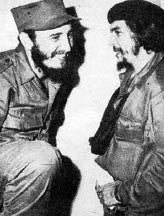 Early 1955 Che Guevara finds work as a doctor in the "Hospital Central" of Mexico City.
Early 1955 Che Guevara finds work as a doctor in the "Hospital Central" of Mexico City.
In June he meets Raul Castro. They become friends. On July 8 Fidel Castro arrives in the Mexican capital. About their first meeting Che said: "I've met him during one of the cool nights in Mexico and I remember that our first conversation was about international politics."
That same night - towards morning - I was one of the future participants of the expedition with the Granma." Fidel Castro about that meeting: "He knew much about the Marxism-Leninism, self-thought, very eager to learn, he was a convinced. When we met Che he was already an educated revolutionary."
.1956
On June 24, the Mexican police have arrested Che together with Cuban comrades.
On July 3 the press agency UPI notifies: "The Argentine doctor Guevara will be deported to his land of origin, because of his presumed participation of the failed conspiracy against the Cuban government of Fulgencio Batista." The Mexican ex-president Lázaro Cárdenas interferes to defend the Cuban revolutionaries. Late July the last, among them Che Guevara, are released. They continue their revolutionary activities in clandestinely.
· With Fidel Castro to Cuba
November 25: the yacht Granma leaves in a stormy night with on board 82 man from the mouth of the river Tuxpán in Mexico.
On December 2 they landed in Los Cayelos, at the East Coast. The next day the Cuban and Latin-American newspapers announced about the expedition: " . . . Fidel Castro, Ernesto Guevara, Raul Castro and all other members of the expedition have perished . . ." Their arrival is noticed and they get hunted. The group splits. On December 5 in Alegría del Pino, Che gets ambushed. Later on he writes about this: "I've got wounded in my neck. I stayed alive thanks to my luck of a cat. A box of bullets I was carrying close to my chest stopped a bullet of a machine gun and it ricochets up to my neck."
With the help of other he could escape in the sugarcane fields. In these circumstances Che had to make the, so often told about, choice between his duty as a doctor and his duty as a revolutionary soldier. To escape he had to choose between a backpack filled with medications and a crate of bullets. It was impossible to take them both. Che takes the crate with bullets and hurries into the sugarcane. Later they leave a great deal of their cargo with a farmer. On December 21 Che's group arrives at a coffee plantation where Fidel is already waiting for a couple of days.
· 1957
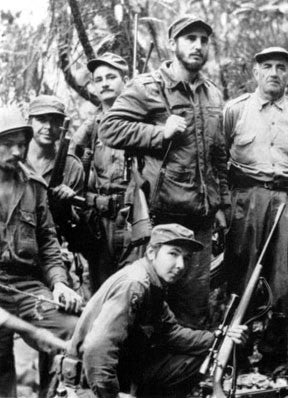
On January they attack the barracks of La Plata. Che: "La Plata was our first victory. It was clear to everybody that a rebel-army existed and was ready for battle. To us it was the confirmation of the chances to the final victory." The ambushes and fights increased. The army bombarded. In April he organises, in order of Fidel extended contacts with the farmers, to create points of support in the area. Year's later Che writes: "The guerrilla and the farmers gradually became one, without anyone could tell when this unity really had performed. I only know that these contacts with the farmers in the mountains made the spontaneous decision turn quickly into a devoted and serious relation. The suffering and sincere inhabitants of the Sierra Maestra have never known how important their part was in the creation of our revolutionary ideology."
In July Che begins to alphabetise Joel, Israel and other guerrilla's. The others also are organised in circles of study about the history of Cuba, the characteristics of the army of tyranny and the importance of the armoured battle. On July 21 Fidel nominated Che commander. About this Che writes: "In a very informal way I was nominated commander of the second colonne of the guerrilla-army (. . .) The dose vanity that anyone has inside of him, made me the proudest man on the world that day."
On September 17, five army-trucks fall into an ambush of the rebels.
· 1958
On January 6 Che writes to Fidel: "I already said that these merits would always be counted for: showing that in America the armoured battle with the support of the people is possible."
In February Che gets interviewed in front of the microphones of "Radio El Mundo" from Buenos Aires: "I'm simply here because I think that the only way to liberate America of the dictators is to defeat them. I'll give all the help I can to make them go down, the sooner the better." 
"Aren't you afraid that your intervention will be regarded as a foreign interference?"
"First of all I don't regard only Argentina as my native country but whole of America. For this I would like to call up to examples such as Marti, and it is exactly on his land of birth that I would make his doctrine come true. Besides you can't call it interference if I want to give myself personally and totally - up to my blood - to a case that seems right to me and that is completely that of the people. A people that wants to get liberated of a tyranny that on itself cheers the armoured interference of a foreign power with aeroplanes, weapons and military advisors. Up to now not even one country accused the North-American interference in Cuban affairs, not one newspaper accuses the Yankees of helping Batista slaughtering his people."
On May 24 and 25 dictatorial troops attacked two mines in Sierra Maestra. It is the beginning of a big offensive. Hostile troops made a forced entry in several points in the Sierra Maestra and threaten to advance. In addition they occupy the supply and communication-lines. The next few days Che participates in a counter-attack that debouch into a defeat for the enemy, a force of over 10,000 men.
On August 21 Fidel writes: "The mission to conduct a brigade from the Sierra Maestra to the province 'Las Villas' and to operate there according to the strategic plan of the Rebel-army, is assigned to Commander Ernesto Che Guevara. (. . .) He is also appointed as head of all units of the 'M-26 de julio' that are operating in this province, in the cities as well as in the countryside. (. . .) The eight brigade has for a strategic object to attack the enemy continuously in the centre of Cuba and to intercept the hostile troop-movements over land from west to east until they are crippled completely."
On December 16 the bridge over the river Falcon by the Central Road is blown up, by that, all cities at the east of Santa Clara, were unable to be reached from Havana. On December 26 Che writes: "The war is won, the enemy has come loudly to his knees, in the east we keep 10.000 soldiers in captivity. Those of Camoguey have no longer a way out. All of this is the result of only one thing: our effort." The next day he decides to march to Santa Clara.
The international press informs the world that Che had died. 'Radio Rebelde' on the contrary sends word: "Latest news of primary importance! Great victory for the eight brigade of Las Villas. Troops under guidance of Ernesto Guevara conquered a blinded train and 300 fully equipped soldiers were captured."
· 1959
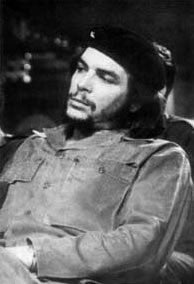 By day-brake of New-Year dictator Batista fled the country. Che Guevara gets the Cuban nationality on February 9.
By day-brake of New-Year dictator Batista fled the country. Che Guevara gets the Cuban nationality on February 9.
From July till August he travels as head of an official delegation to the United Arab Emirates and Egypt where he meets Nasser. The trip goes on to India, Thailand, Japan, Indonesia and Pakistan. They turn back via Eastern and Western Europe to close up in Morocco. On his return Che declares to be surprised for the sympathy that the Cuban revolution evoked all over the world.
On October 17 Che advises university students to: "(. . .) get contact with the people, not to 'help' them with knowledge or what so ever - like an aristocratic lady that hand out a coin of money to a beggar - but to become participants of the revolutionary forces that rule over Cuba today. To place your shoulders under the extension of the revolution and, at the same time, to get experience that might be more important than all interesting things that you learn in your lessons." On November 23 he introduces the first 'day of voluntary labour' in Cuba.
· 1960
At the end of 1960 the U.S. establishes a complete trading-embargo against Cuba. Che leads an official Cuban delegation in a tour to different socialistic countries: from the Soviet-Union and Eastern Europe to China and Northern Korea. From there, back to the Soviet-Union, Eastern-Germany and Czecho-Slovakia. Early '61 the U.S. breaks all diplomatic relations with Cuba.
· 1961
On April 15 are the Cuban airports bombed by U.S. -planes. On April 17 there is the invasions in the Bay of Pigs: 1,500 CIA-mercenaries attack Cuba supported by the American fleet and airforce. The contra's want to cause a revolt of the people. In barely 72 hours they get completely defeated by the Cuban nation. 1.200 of them are being captured.
· 1964
 May 17: confronted with new acts of sabotage of the imperialism in a harbour in the south he says: "We have rendezvous with history, and we simply can not permit ourselves to be afraid! We must maintain the same enthusiasm and faith. Build factories with our left hand, aim the rifle with the right hand and crush the worms with our heels."
May 17: confronted with new acts of sabotage of the imperialism in a harbour in the south he says: "We have rendezvous with history, and we simply can not permit ourselves to be afraid! We must maintain the same enthusiasm and faith. Build factories with our left hand, aim the rifle with the right hand and crush the worms with our heels."
In August he talks about the situation in Congo: "What is happening in Africa, where only two years ago the prime minister of Congo was murdered and quartered, where North-American monopolies have installed themselves and the battle to own Congo has turn loose? Why? Because there is copper and radioactive minerals in their soil, because Congo has exceptionally strategic raw materials? Therefor a leader of the people, who was so naïve to believe in justice without render himself an account of the fact that justice gets expelled by power, got murdered. That is how he became a martyr of his people."
Later on Che speaks to the general meetings of the UN in New York. He accuses in powerful terms the part of the UN in the murder of Lumumba and to help to get in the saddle, Tshombe as Congolese president, it was the same man that had tried to tear off the province Katanga of the rest of the Congolese nation. "All free people of the world must be prepared to declare to revenge the Congolese crime."
· 1965
Che arrives in Brazzaville on New Years day and begins with an official African journey. When he gets back in Cuba he convokes a secret conference with a hundred comrades who have great battle-experience. They are the future participants of the international mission in Congo. On February he arrives in Dar El Salaam together with different African revolutionary leaders who asked Cuba for weapons, training and finance. There he also meets Laurent Kabila and his general staff. They agree that the main African enemy is the North-American imperialism. In reply to Kabila's question to train guerrilla's in Cuba, Che says no. He explains the advantage of training on their proper terrain.
On March 31 Che writes a letter of goodbye to Fidel Castro. Later it will seem that Che, naturally clandestine, went to Congo. The U.S. abuse the fact that Che does not longer appear in public to spread the rumour that he have been liquidated by Fidel because of heavy ideological conflicts in the highest leadership in Cuba. In their broadcast to China the U.S. claim that Che was murdered because of his pro-Chinese point of view, and in the broadcasts to the East they claim the opposite.
On March 24 Che arrives from Tanzania near the harbour of Kigoma at the shore of the Lake Tanganyika. He disembarks with 14 Cubans outside the harbour to avoid the Belgian mercenaries patrol. Doing that they land in the water. From there he reaches Kibamba in Congo.
On May 9 he succeeds making contact with the first group of guerrilla's. He explains them that he has come to give them a guerrilla education, on demand of Gastón Soumaliot and Laurent Kabila to Fidel Castro. He wants to fight on their side in operations they decide. He is at their disposal. He starts with a school of warriors that gets the name "La Base".
On July 7 Che Guevara meets Laurent Kabila who promises to accompany him in a visit to several fronts on the inland. Kabila however leaves for Kigoma and the visits are getting postponed.
On August 16, 7 soldiers die in an ambush of the guerrilla, among them two Belgian non-commissioned officers and three South-Africans. In November the situation seems at the different fronts — among other things because of continuous discussions between the various revolutionary leaders — so confused that more and more guerrilla's leave the battle. Together with the Congolese the decision is made that the Cubans will retreat. The mission took seven months in which Cubans participated in over 50 actions.
· 1966
In July Che travels in the greatest secrecy to Havana, were he prepares a new mission to Bolivia in consultation with Fidel.
Across Moscow, Prague and Vienna Che Guevara travels via Brazil to Bolivia were he arrives on November 3.
· 1967
Che writes: "As I thought the attitude of Monje (the under-secretary of the Bolivian KP) was avoiding and later traitorous. His party is already getting armed against us. I don't know where that will take him but it will not slow us down, and maybe in long terms it will be an advantage for us, I'm almost sure of that. The most honest and competitive people will stand on our side, although they have to go true a severe crisis of their conscience. So far Guavara has reacted well. We'll see how he and his people will line up (. . .) The actual phase of the guerrilla will now begin, we will test our troops. Time will tell which are the perspectives of the Bolivian revolution. Of all things that were planned the recruit of Bolivian comrades in battle was the slowest."
In March the analysis goes as followed: "This month there was no lack of incidents, but the total looks like this: phase of consolidation and purification of the guerrilla, slow development with few elements that came from Cuba - and they don't perform badly - and elements of Guevara's group who were very weakly in general (two deserters, one loose-tongued whom we kept as prisoners, three that got scratches and two weaklings). Now the phase begins of actions with an exact and spectacular attack. We have to hit the road much sooner as I wanted, and with the burden of four possible talebearers. The situation is not good but a new stage of test begins for the guerrilla and it will do her good if they overcome it. The guerrilla consists of 29 Bolivians, 16 Cubans and 3 Peruvians."
 In the months that follow Che and his man get more and more count off communication problems with La Paz and Cuba through which they finally have to operate completely isolated. To get connected with the farmers is much harder than they have thought. About that he writes in May: "The farmers still don't join us, although it seems that slowly they don't fear us anymore and they seem to admire us. It is a slow and patient process." In June he writes: "The farmers are still aloof. It is a vicious circle: to attract them we must have more actions in populated areas, but therefor we need more man. (. . .) The army stands nowhere in her military task, but it does dangerous work with the farmers that we may not leave without interference. If not all farmers will become tale-bearers, out of fear or because of the lies they tell them about our intentions."
In the months that follow Che and his man get more and more count off communication problems with La Paz and Cuba through which they finally have to operate completely isolated. To get connected with the farmers is much harder than they have thought. About that he writes in May: "The farmers still don't join us, although it seems that slowly they don't fear us anymore and they seem to admire us. It is a slow and patient process." In June he writes: "The farmers are still aloof. It is a vicious circle: to attract them we must have more actions in populated areas, but therefor we need more man. (. . .) The army stands nowhere in her military task, but it does dangerous work with the farmers that we may not leave without interference. If not all farmers will become tale-bearers, out of fear or because of the lies they tell them about our intentions."
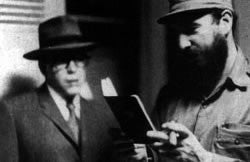 In the meantime the U.S. supplies more weapons and advisors to the Bolivian army. The land gets harassed with ever more strikes and the fame of Che's man rises in Bolivian and world press every day: "On political field the official statement of the government is, that I'm really in Bolivia and not murdered in Cuba, the most important. They even add that the army has to deal with perfectly trained guerrilla's, among them even Vietcong's who had defeated the best trained American marines."
In the meantime the U.S. supplies more weapons and advisors to the Bolivian army. The land gets harassed with ever more strikes and the fame of Che's man rises in Bolivian and world press every day: "On political field the official statement of the government is, that I'm really in Bolivia and not murdered in Cuba, the most important. They even add that the army has to deal with perfectly trained guerrilla's, among them even Vietcong's who had defeated the best trained American marines."
In September the guerrilla gets further isolated and they have many losses in an ambush of the army. On October 8, in the village La Higuera, Che and two comrades fall into the hands of the army. Two comrades die. A Bolivian colonel and a Cuban, who works for the CIA, come on the spot by helicopter. On higher command they decide to slaughter Che and his comrades Willy Cuba and Juan Pablo Chang immediately. A Bolivian soldier does the job, his eyes turned side wise. While international press barons offer up to $125,000 for the diary of Che, Bolivian revolutionaries make sure that copies of it reach Cuba the same year. Doing that the CIA-plan fails of making anti-communistic propaganda with falsifications of the original.

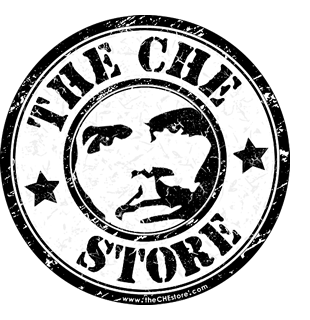
Very nice cheguvera biography
Chigovera was legend